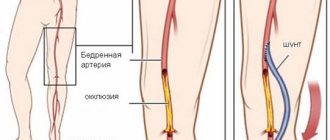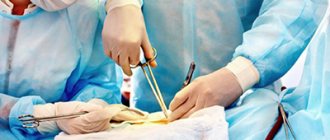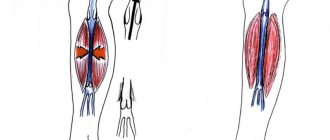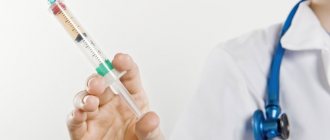Coronary artery bypass surgery is a surgical intervention that is performed when the blood flow of the coronary arteries is reduced by more than 50%, and consists of creating a bypass anastomosis (shunt) of the affected area. The purpose of the operation is to restore blood circulation to the heart muscle. This is the only radical way to treat angina syndrome in coronary artery disease.
Bypass anastomosis is performed by transplanting a section of vein from the lower limb, forearm or pectoral muscle. In many countries, the operation is performed under general anesthesia using artificial circulation. For coronary artery bypass grafting in Germany, only innovative cardiac surgery techniques are used, which allows such operations to be performed on a “working” heart.
These minimally invasive techniques allow surgery to be performed through a small incision in the chest. The manipulation is performed without a heart-lung machine, which eliminates the risk of developing vascular complications, infection and shortens the recovery period.
Coronary artery bypass surgery eliminates chest pain in moderate and severe forms of angina. This is the most effective method that allows patients to perform physical activity without pain and shortness of breath and continue to lead an active lifestyle.
Indications
CABG is an operation that is primarily required for patients with severe angina that is resistant to drug therapy. In addition, surgical treatment may be recommended in the absence of symptoms. There is silent myocardial ischemia, which is no less dangerous. It is not felt by the patient, but can be diagnosed using ECG and Holter monitoring.
Indications for CABG can also be determined using coronary angiography. This is an x-ray test in which contrast is injected into the arteries of the heart. The main cause of mortality from coronary disease is atherosclerosis and disruption of the integrity of the atherosclerotic plaque. The blood vessel is torn, and a blood clot forms at the site of damage. It clogs the coronary artery, resulting in myocardial infarction.
Coronary angiography allows you to identify large obstacles to blood flow (atherosclerotic plaques) and assess the risk of acute cardiovascular events. A high degree of coronary artery disease requires cardiac CABG.
Based on the results of coronary angiography, the main indications for CABG are:
- Narrowing of the lumen of any coronary artery by 75% or more
- Reduction in the lumen of the left coronary artery trunk by 50% or more
The location of stenosis (impaired patency) of the coronary arteries is also assessed. The more proximal it is (closer to the heart), the worse the blood supply to the myocardium. CABG surgery on the heart will be most successful if normal blood circulation is observed beyond the narrowing.
When is stenting performed?
Stenting is done when the lumen of the arteries is narrowed by more than half. This is an effective operation that is performed even in the presence of concomitant chronic diseases and infectious processes in the body. Initially, when deciding on surgical intervention, the question of stenting is almost always raised. If it cannot be done, then bypass surgery is performed.
Contraindications
Coronary artery bypass grafting (CABG) may not be performed on patients even if there are indications for surgery. This may be due to the presence of contraindications. These are diseases and conditions of the body that make surgery too dangerous or unsuccessful.
Main contraindications for cardiac CABG:
- Reduced left ventricular ejection fraction by up to 30%
- Congestive heart failure
- Impaired blood flow in all coronary arteries
- Severe concomitant diseases
In case of circulatory disorders in all coronary arteries, preference is given to laser myocardial revascularization or cell therapy.
What is cardiac bypass surgery?
Bypass surgery is an operation to replace the affected area of a vessel. In the vast majority of cases, this is the coronary artery. Radical surgical intervention significantly increases the patient's life expectancy, reduces the risk of developing acute coronary syndrome, angina pectoris, and heart attack.
The operation lasts from 4 to 6 hours. The patient is put into medicated sleep. Access to the heart is made through an incision in the sternum or intercostal space. The essence of the operation is to create a bypass for blood flow. To do this, a section of the radial, internal mammary artery or femoral vein is taken (at the discretion of the doctor). The vessel is replaced, after which the chest wall is sutured.
How is the operation performed?
The operation can be performed using a heart-lung machine. In addition, in developed countries, including Germany, off-pump CABG is increasingly being used.
The essence of surgery is to create a bypass path for blood flow. For this purpose, shunts are created - additional vessels that leave the aorta and flow into the coronary arteries - beyond the level of narrowing. A person’s own veins or arteries are used as prostheses. This may be the great saphenous vein or the radial artery.
Usually 3 bypasses are created - for the largest coronary arteries:
- Anterior interventricular
- Envelope
- Right
In 20% of patients, 4-8 anastomoses are installed. More preferable is CABG (coronary artery bypass grafting) on a beating heart.
The advantages are as follows:
- Blood cells are not damaged
- Rehabilitation after CABG is faster
- The operation has a shorter duration
In this case, complications after CABG on the heart are less common. Because there is no risk from those that are directly related to the use of a heart-lung machine. This is pulmonary edema, embolic damage to the blood vessels of the brain or kidneys, hypoxia (oxygen starvation) of internal organs.
Preparation for coronary artery bypass surgery
At the Federal Scientific and Clinical Center of the Federal Medical and Biological Agency, before performing coronary artery bypass surgery, the doctor draws up a preoperative examination plan. It includes laboratory tests and instrumental studies:
- general blood test, urine test;
- blood biochemistry;
- expanded coagulogram;
- ADP platelet aggregation;
- blood type and Rh factor;
- markers of infections: HIV, hepatitis B, hepatitis C, syphilis;
- Pro-BNP, SRP;
- ECG;
- Echo-CG;
- X-ray examination;
- EGDS (maximum duration – 1 month). An exception is patients with lesions of the left artery trunk;
- Ultrasound scanning of the brachiocephalic arteries (maximum duration – 3 months);
- Ultrasound scanning of the arteries of the lower extremities (maximum duration – 3 months);
- Ultrasound scanning of the veins of the lower extremities (maximum duration – 7 days);
- FVD (maximum duration – 7 days);
- Ultrasound of internal organs;
- coronary angiography.
If there is a concomitant pathology, additional tests may be prescribed:
- History of stroke - CT scan of the brain.
- thyroid diseases - TSH, T4, T3 (maximum duration - 30 days). Consult an endocrinologist if there are changes in the hormonal profile.
- diabetes mellitus - glycemic curve (maximum duration - 7 days). Consultation with an endocrinologist for glycemia more than 10 mmol/l.
- Gout - uric acid (maximum duration - 1 month). If the value exceeds 420 µmol/l, consult a therapist and select therapy.
- consultation with a dentist, urologist, gynecologist.
The day before surgery, the patient is examined by a surgeon and an anesthesiologist. On the eve of CABG, it is recommended to have a light dinner no later than 12 hours before surgery, not to eat or drink the night before, and to stop taking medications. A cleansing enema is given at night. In the morning the patient takes a shower.
After signing the informed consent, the patient is given premedication - medications are administered that will reduce emotional tension and help calm down. After 40-60 minutes, the patient is taken to the operating room.
At the cardiology center of the Federal Scientific and Clinical Center of the Federal Medical and Biological Agency, you can take all the tests and undergo studies recommended by your doctor before the operation. The structure of our center allows you to quickly go through the preparatory preoperative stage and get the results in hand. Having our own laboratory, we are responsible for the accuracy of tests and the quality of clinical and laboratory studies.
Recovery after coronary artery bypass surgery
Immediately after surgery, the patient is on artificial ventilation for a certain time. And after natural breathing is restored, prevention of congestion is required. To do this, the patient is asked to inflate rubber balls several dozen times a day. As a result, the lungs expand.
Recovery from open-heart CABG involves caring for the surgical wound. The incision is made down the middle of the sternum. In addition, there is damage to the lower extremities - where the doctor took the material for bypass (the great saphenous vein). Skin wounds heal in 1-2 weeks. After this, the person is allowed to wash in the shower.
Banding after CABG is not mandatory, but is preferred to reduce the risk of sternal suture dehiscence. While skin heals in an average of 10 days, bone heals over several months. Patients often ask how long to wear a bandage after CABG. It is usually used for 4-6 months.
There should be no arrhythmia after CABG. If it occurs, it is not a consequence of the operation. There are a large number of arrhythmias. Some may be caused by myocardial ischemia, others by independent pathologies, and still others by previous myocardial infarction. Typically, the heart rhythm normalizes after surgery due to improved blood supply to the heart muscle.
The consequences of CABG surgery are assessed 2-3 months after it is performed. By this time, angina should no longer bother the patient. The person is given a stress test and IVF is removed to understand how much the blood supply to the myocardium has improved. If there is no pain after CABG during physical activity, the operation is considered successful.
Recovery after CABG can be carried out in a clinic, in a sanatorium or at home. Naturally, the most successful rehabilitation will be under the guidance of a specialist. But some patients undergo rehabilitation after CABG at home, which is usually associated with a desire to save money. If there is no money for quality restoration, you need to take care of yourself. Exercise after CABG surgery is very important. You need to start with walking - at least 1 kilometer a day. Then - gradually increase the load.
Patients often ask when they can sleep on their side after CABG. You can lie on your side almost immediately, if that’s comfortable for you. Most doctors do not prohibit this from happening to their patients, since sleeping on the side does not affect the results of the operation.
Send a request for treatment
Risks of using an IR device
Vascular bypass with open access and cardiac arrest is associated with the risk of developing the following complications:
- possibility of bleeding;
- necrosis of a portion of the heart muscle;
- incomplete fusion of the thoracic incision;
- renal failure;
- venous thromboembolism;
- cerebral artery stroke;
- amnesia (memory loss);
- large scars on the chest;
- pronounced pain symptom.
After the operation, until the postoperative wound has completely healed, you should not take a bath, use gels, or rub in the suture area. You should not take a hot shower or use lotions.
Life after CABG on the heart
After CABG, a person’s life changes only for the better. Full recovery takes about 6 months. During this time, the sternum grows together and tolerance to physical activity increases. Disability after CABG is not issued. Moreover, disability after CABG can be removed if you become able-bodied again. And if the operation is successful and there is no concomitant pathology, this will happen.
Several important questions that patients often ask regarding lifestyle after surgery:
- Showering - allowed 10 days after surgery (plus or minus 2 days) if the skin wound has healed
- A bath after cardiac CABG is allowed after 2-3 months, when you undergo a follow-up examination (because temperature changes can provoke spasm of the coronary arteries and an attack of angina)
- Alcohol after CABG is allowed in moderation after the early postoperative recovery period
- Smoking is prohibited because it leads to narrowing of the coronary vessels and increases the risk of atherosclerotic damage.
- Gymnastics after CABG - carried out under the guidance of a specialist in physical therapy, required to strengthen the heart muscle and improve tolerance to physical activity
- Diet after coronary artery bypass grafting is desirable, but not mandatory (you can reduce the consumption of animal fats to reduce the risk of atherosclerotic plaques in places where they do not yet exist)
Having surgery does not guarantee that you will not have angina or myocardial infarction in the future. Because CABG only allows you to bypass narrowed areas of blood vessels. But after a few years, new atherosclerotic plaques may appear. Therefore, it is important to adhere to a healthy lifestyle and take medications prescribed by your doctor.
Cardiac surgeries with cardiopulmonary bypass (CPB)
Access with the traditional method is performed along the midline of the sternum. The heart is turned off from the blood circulation. Life functions are supported using an infrared apparatus, which is connected to the aorta and vena cava. The blood is saturated with oxygen and enters the body. The gas exchange process occurs in the IR apparatus itself, where the blood also maintains the required temperature and is filtered.
Coronary artery bypass surgery is performed on a non-functioning heart. The surgeon makes an anastomosis between a healthy area of the coronary vessels and a vein. The minimum time to complete the operation is three to five hours. The heart is included in the blood circulation after completion of surgery on all affected vessels.
Coronary artery bypass surgery has varying degrees of complexity. This depends on the number of arteries affected and the general condition of the patient. Therefore, the duration of the procedure is determined individually. The more anastomoses that need to be implanted, the longer the procedure takes.
Where is the best place to do CABG?
Coronary artery bypass surgery is performed all over the world. Many residents of the CIS undergo CABG in Moscow. Often, residents of developing countries seek to travel abroad for surgery. Because it is very dangerous and requires a long recovery. A better-quality operation provides better treatment results and a less painful rehabilitation period.
Residents of many countries go to the States for CABG surgery. The medicine there is really high quality, but very expensive. It is cheaper to do CABG in Israel. We recommend Germany. This is the “golden mean” - German clinics are able to provide the same high quality of medical services as the United States, but it is easier to come here for treatment, and the services of doctors are cheaper.
The main advantages of coronary artery bypass surgery in Germany:
- Surgery is performed on a beating heart if possible given the clinical situation
- The best doctors work in Germany - they come here from all over the world to practice medicine. And when performing CABG, the qualifications of the cardiac surgeon play a significant role
- German clinics are equipped with the latest technology
- After the operation, the person is provided with high-quality care and medicinal support, which improves the tolerability of the early postoperative period
- The opportunity to undergo high-quality rehabilitation, which will return a person to his former lifestyle and restore his ability to work
Safe and effective aortic surgery can be performed at the Helios Klinik Krefeld, a medical center of maximum care, continuously collaborating with leading universities and research centers around the world. The Department of Adult and Pediatric Cardiac Surgery, under the direction of Prof. Dr. med. Jürgen Ennker, has a number of its own developments in the field of surgical interventions on the thoracic and abdominal aorta. These are coronary artery bypass grafting using minimal extracorporeal circulation (a special heart-lung machine is used), coronary artery bypass grafting on a beating heart, and minimally invasive direct coronary artery bypass grafting. The department also uses hybrid endoprostheses of the thoracic and abdominal aorta, and performs classical reconstructive interventions with the installation of self-expanding stents. At the same time, the department’s specialists perform both primary and more complex revision interventions on patients of all ages.
Treatment in Germany can be organized for you by ]Booking Health[/anchor]. We have been working in the medical tourism market for a long time, so we can choose the best clinic for you. You will be treated by the most reputable German specialists.
Thanks to our help, you can save up to 70% of the total costs of treatment and its organization. We have direct contracts with all major clinics in Germany. For treatment you do not have to take out insurance for foreign patients. You will receive Booking Health insurance, which will cover all unexpected medical expenses during the treatment period and for 4 years after it.
Early postoperative period
After the operation, the patient lies in the intensive care unit for several days. During this period, vital signs are monitored, the seams are treated with antiseptic solutions, and the drainages are washed. Every day a blood test is performed, a cardiogram is recorded, and body temperature is measured. A slight fever and cough are normal at first. After the ventilator is turned off, the patient is taught breathing exercises to effectively remove fluid from the lungs and prevent congestive pneumonia. For the same purpose, the patient is often turned to the sides and X-rays of the OGK are performed several times. The patient receives the necessary medications.
If the condition is stable and the patient’s life is not in danger, he is transferred to the general ward to further observe and recover after heart bypass surgery. The motor mode is gradually expanded, starting with walking near the bed, along the corridor. Areas of postoperative wounds are treated. The patient wears elastic stockings to reduce swelling of the lower leg. Before discharge, the sutures from the chest are removed. The length of stay in the hospital ranges from a week or more.
Complications
Complications after bypass surgery can occur during surgery and after discharge. As stated above, the risk of adverse effects is assessed before intervention and depends on the background condition of the body. The most common problems include:
- acute renal failure;
- thrombosis;
- cardiac arrest;
- rhythm disturbances;
- myocardial infarction;
- infection, including sepsis;
- pneumonia;
- bleeding;
- pericarditis and cardiac tamponade;
- pulmonary edema;
- cardiogenic shock;
- neurosis.
A long-term complication is stenosis of the shunts due to non-compliance with the doctor’s recommendations. In this case, the patency of the vessels becomes more difficult again, and a typical clinical picture of angina occurs. This situation requires repeated coronary artery bypass grafting.
Reviews from patients after bypass surgery
There are a large number of methods for restoring blood circulation in the heart muscle: stenting, ballooning and others. Bypass surgery is the most radical possible technique, allowing you to resume oxygen supply by replacing the vessel. Patients who undergo such an intervention always feel an improvement in their condition. It is associated with the complete disappearance of symptoms, increased exercise tolerance and quality of life. We never recommend refusing to carry out this procedure in cases where there are reasoned indications for it, because only in this way does the patient have a chance of recovery.
Space numbers have become real
– That is, an emergency hospital, the structure of which will include a vascular center, can be said to be an ideal fit?
– Our structure for providing care to patients with cardiovascular diseases has been working for several years. Judge for yourself: in the emergency hospital there are three departments of cardiology, departments of X-ray surgery, neurosurgery and neurology - these are six departments that, in principle, should deal with vascular accidents. In 2014, I was appointed head of the department of x-ray surgical methods of diagnosis and treatment of the hospital, and we were faced with a problem: there are many patients, but we operate on few. Why? The new technologies that we have begun to introduce are very expensive. Stents, catheters - all this equipment is miniature, disposable, but minimally invasive methods allow you to solve the patient’s problem quickly and with minimal losses. We managed to create a small bed capacity in the X-ray surgery department, a prototype of a future vascular center, although not with the same capabilities as now. It was opened on January 1, 2016 by decision of the city duma, the regional Ministry of Health and the health department of Rostov-on-Don. We were given quotas for 300 operations per year. Then we performed 150 operations a year, half as much! We mainly operated on patients with heart attacks and pre-infarction conditions. The question became: where to find specialists? We recruited staff in four months, and now they are a very strong, united team. Currently we perform about 900 operations per year.
– Where did you find good specialists? Lured from other hospitals, discharged from Moscow?
– To be honest, we raised ourselves. They sent me to various symposiums and advanced training courses. You can go anywhere, but within reasonable limits. There is a sea of information, and we still need to cope with it, and while studying theory, we must not forget about practice. The surgeon does not have time to sit and think; the surgeon makes a decision within a second.
In parallel with the x-ray endovascular surgeon, cardiologists, resuscitators-anesthesiologists, and ultrasound doctors immediately join the work. Patient logistics are structured in such a way that the diagnostic stage takes 5–7 minutes. And a decision follows. In particularly difficult cases, we assemble a consultation of a multidisciplinary team of doctors.








